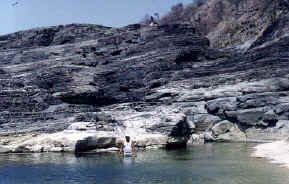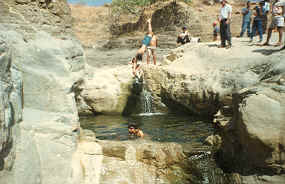LANCONES - LA CHORRERA
|
LA CHORRERA |
|
|
|
|
LA CHORRERA Revisando
el Protocolo de Río de Janeiro entre Perú y Ecuador, en su artículo
octavo, lado occidental, numeral 5°. Dice: “Quebrada de Pilares y del Alamor hasta el río Chira”;
numeral 6°.: “Río
Chira, aguas arriba”. Precisamente,
ubicada en plena línea fronteriza, en el distrito de Lancones, se ubica
la quebrada de Pilares que sirve de límite con Ecuador, y que los
lugareños llaman “Corralitos” o “La Chorrera”, siempre discurre
un hilo de agua, que en ciertos tramos adquiere un color azulino y en
otros se torna verduzco, formando un pequeño cañón con varias pozas o
lagunas, hasta terminar en medio de dos enormes piedras, que a manera de
peroles reciben el agua, con más de dos metros de profundidad y no hay
quien se resista a darse un “clavado” en estas mansas y cristalinas
aguas. El calor es fuerte, pero una suave brisa refresca el paraje casi
desértico. El hilo de agua continúa formando otras lagunas limitadas
por paredes de piedra caprichosamente talladas por el agua en el tiempo,
que forman una serie de curvas con profundidades que alcanzan hasta los
10 metros. El agua sigue discurriendo por la quebrada terminando en la
represa de Poechos. Para
llegar a la Chorrera, se parte de Lancones hacia el Alamor, de aquí
hasta Pichiche, seguimos hasta llegar al caserío de La Chorrera, y
caminando, como disfrutando del hermoso paisaje de seca y silvestre
vegetación, se llega al manantial, en el mismo límite con Ecuador. No muy lejos de aquí,
en el caserío de Cabrería, se encuentra la hermosa y paradisíaca
Laguna Encantada. La zona encierra un gran potencial turístico. Todo un
paraíso en medio del desierto, ideal para practicar turismo de aventura
|
LA CHORRERA Revising the Protocol of River of Janeiro between Peru and Ecuador, in their article eighth, western, numeral side 5°. says: “Gulch of Pillars and of the Alamor to the river Chira”; numeral 6°.: “I Laugh Chira, waters up.” In fact, located in full border line, in the district of Lancones, the gulch of Pillars is located that serves of limit with Ecuador, and that the villagers call “Corralitos” or “The Chorrera”, a thread of water always reflects that acquires an almost blue color in certain tracts and in other you restitution of an almost green color, forming a small canyon with several puddles or lagoons, until finishing amid two enormous stones that receive the water by way of kettles, with more than two meters deep and there is not who resists to be given a “nailed” in these meek and crystalline waters. The heat is strong, but a soft breeze refreshes the almost deserted place. The thread of water continues forming other lagoons limited by stone walls capriciously carved by the water in the time that form a series of curved with depths that reach until the 10 meters. The water continues reflecting for the gulch finishing in it dams it of Poechos. To arrive to the Chorrera, leaves of Lancones toward the Alamor, of here until Pichiche, we continue until arriving to the village of The Chorrera, and walking, as enjoying the beautiful landscape of dry and wild vegetation, you arrives to the spring, in the same limit with Ecuador. Not very far from here, in the village of Cabrería, the beautiful and paradisiac Charmed Lagoon is. The area contains a great tourist potential. An entire paradise amid the desert, ideal to practice adventure tourism |
LA CHORRERA Das Protokoll von Fluß von Janeiro zwischen Peru und Ekuador revidierend, in ihrem Artikel achter, West, numerale Seite 5°. sagt: “Bergschlucht von Pfeilern und vom Alamor zum Fluß Chira”; Ziffer 6°.: “ich lache Chira, Wasser auf.” In der Tat, fand in voller Rand-Linie, im Gebiet von Lancones, die die Bergschlucht von Pfeilern gefunden wird, der das von Begrenzung mit Ekuador dient, und daß die Dorfbewohner rufen, “Corralitos” oder “Der Chorrera”, ein Faden von Wasser spiegelt immer wider, das erwirbt eine fast blaue Farbe in bestimmten Gebieten und in ander Sie Rückerstattung einer fast grünen Farbe, das Bilden eines kleinen Cañons mit mehreren Pfützen oder Lagunen, bis das Beenden inmitten zwei enormer Steine, die das Wasser über Kesseln bekommen, mit mehr als zwei Metern tief und es gibt nicht, wer widersetzt, um gegeben zu werden, ein “nagelte” in diesen sanftmütigen und kristallenen Wassern. Die Hitze ist stark, aber eine weiche Brise erfrischt die fast verlassene Stelle. Der Faden von Wasser setzt das Bilden von anderen Lagunen, die von Stein-Mauern begrenzt werden, die kapriziös vom Wasser in der Zeit geschnitzt werden, fort, daß Form eine Folge von bog mit Tiefen, die bis die 10 Meter erreichen. Das Wasser setzt das Widerspiegeln fort, denn die Bergschlucht, die in ihm beendet, staut es von Poechos. Um zum Chorrera anzukommen, Blätter von Lancones zum Alamor, von hier bis Pichiche, wir setzen bis das Ankommen zum Dorf von Dem Chorrera fort, und das Gehen, als Sie die schöne Landschaft trockener und wilder Vegetation genießen, kommen Sie zum Frühling, in der gleichen Begrenzung mit Ekuador, an. Nicht genau weit weg von hier, im Dorf von Cabrería, das schön und paradisiac bezauberten, Lagune ist. Das Gebiet enthält ein großes Tourist-Potential. Ein ganzes Paradies inmitten der Wüste, ideal, Abenteuer-Tourismus zu üben |

